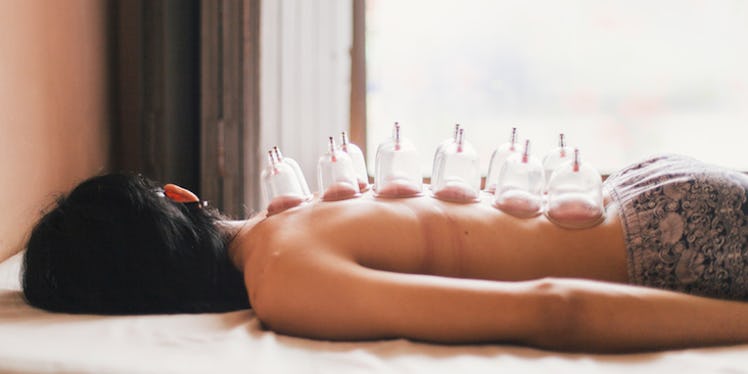
5 Things To Know About Cupping, The Therapy That Many Olympic Athletes Swear By
With the 2018 Winter Olympics coming up in just about a month, it's time to get pumped and watch some incredibly talented athletes do their thang. Every year, while I'm sitting in front of my TV in awe, I can't help but wonder what sorts of rituals or therapies these athletes swear by to get ready for the competition — like cupping, for example. What is cupping therapy, and does it really live up to all the hype?
For starters, let's make it clear that cupping is actually not a new, modern type of therapy or wellness trend. In fact, cupping is an ancient Chinese healing practice, and to put it simply, it's more or less the equivalent of getting a deep-tissue massage, but instead of kneading and rubbing your muscles, your practitioner is pulling on them with a suction cup.
Cupping therapists apply pressure to a person's body (most commonly on the back) with sterilized glass, bamboo, or rubber cups, and this serves to relieve the tension you're holding in different areas of the body by lifting your connective tissues — aka fascia — away from your skeletal system.
This probably sounds highly unpleasant and not at all worth the hype, but it's actually a lot more beneficial than it seems. The reason why the therapy is so popular among athletes like Michael Phelps and Alex Naddour is because it's said to majorly speed up muscle recovery time, increase flexibility, create better circulation in the body, and much more.
So, if you want to take a cue from some of your favorite athletes' self-care routines, give cupping a shot and see what it's all about. Here are five things to know before you book your first appointment.
01Cupping Looks A Little Scary, But It's Super Safe
Cupping is a form of alternative medicine that may seem intimidating to try at first, but it's actually very safe and ultimately harmless. As long as you make sure that your therapist is certified in traditional Chinese medicine (TCM), and you're not trying cupping by yourself at home, you have nothing to worry about.
Tell your healer your specific goals for the appointment, and let them do their work based on what you want to relieve or heal in your own body. Make sure you let the practitioner know if you're pregnant or have any allergies before the treatment, as well.
02There Are Multiple Methods To The Madness
There are multiple types of cupping that have been used for centuries in China, but the most common ones in the U.S. are fixed cupping and moving cupping.
During fixed cupping, the TCM practitioner simply suctions the cups to your body, and leaves them where they are for the duration of your visit. With moving cupping, on the other hand, your healer puts oil or cream on your skin and slides the cups along your body for a more active and hands-on approach.
03It Feels Different For Everyone
Cupping isn't supposed to hurt, but the specific sensations vary depending on the person and environment.
Some people report that the process of suctioning their fascia feels similar to the dull feeling of stubbing your toe, while others say that it's not painful at all and actually pretty pleasant. Others describe the experience as a mildly tight, yet soothing feeling.
04It's Often Referred To As A Pseudoscience
Since there's a pretty noteworthy lack of actual scientific evidence to back the effectiveness of cupping, there are some people who claim that everything about the ancient practice is nothing but a pseudoscience. And, even with the research that does exist on the subject, a lot of people chalk up the benefits of cupping to nothing more than a placebo effect.
If you're trying cupping to heal or soothe a specific condition, it's probably best to combine it with some kind of conventional physical therapy in order to guarantee results.
05The Weird Marks Will Linger, But Only Temporarily
One of the most well-known parts of cupping is the red, blue, or purple, circular discoloration that the therapy leaves behind on your body. Those marks can look super intense and intimidating from afar, but rest assured, they only linger for a few days after your therapy session, and then they slowly start to fade away.
Some people say that these marks indicate how much internal blockage or stagnation you have, and thus proves that cupping actually works, while others say that the circular "bruises" suggest no indication on the effectiveness of the therapy and simply show how much muscular tension you're holding.
Hey, there's only one way to find out for sure, right?